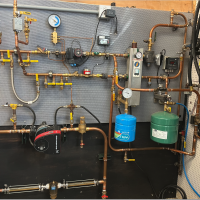Welcome! Here are the website rules, as well as some tips for using this forum.
Need to contact us? Visit https://heatinghelp.com/contact-us/.
Click here to Find a Contractor in your area.
If our community has helped you, please consider making a contribution to support this website. Thanks!
Best Of
Re: Wall Brackets for Wall Hung Cast iron radiator
I make these brackets. I cut a piece of 3” pipe about 2” long and then cut that piece in half to make two u shaped pieces. I weld that piece of pipe to a piece of 1-1/2” X 3/8” flat stock about 6” long. 3/8” provides a distance from the wall that’s good for me. (It could be spaced farther out if you like). I drill 3 or 4, 5”16” holes in the flat stock to attach the bracket to the wall. The hole size depends on the anchors used.
I like to use two brackets because they have to go on the wall before the radiator. Install them level spaced out at each end. The radiator will nestle into two brackets nicely. The brackets need to be strongly attached to the wall. If it’s wood framing long strong screws need to go into the center of a wall stud.
The top attachments hold the radiator in place. I usually set the radiator on the brackets and mark where the top attachments will be. Sometimes I have to remove the radiator to get the top “Sammy” attachment into the wall before resetting the radiator and screwing in the threaded rod with nuts and washers, flat stock or any good means to pinch the radiator in place.
Please let me know if you have any questions.
I like to use two brackets because they have to go on the wall before the radiator. Install them level spaced out at each end. The radiator will nestle into two brackets nicely. The brackets need to be strongly attached to the wall. If it’s wood framing long strong screws need to go into the center of a wall stud.
The top attachments hold the radiator in place. I usually set the radiator on the brackets and mark where the top attachments will be. Sometimes I have to remove the radiator to get the top “Sammy” attachment into the wall before resetting the radiator and screwing in the threaded rod with nuts and washers, flat stock or any good means to pinch the radiator in place.
Please let me know if you have any questions.
 JimP
JimP
1
Re: Proper pitch?
No, don't measure the floor. No telling what way that thing is pitching.
You have a tall section over there on the left that is messing up your measurement when you use the piece of wood. I wouldn't use that.
Probably best in your case is the one where you have the level on the bottom of the radiator. Try to get that pitch correct.
If there is still gurgling after you do that, the gurgling might be coming from the near-horizontal section of pipe that is typically just under the floor. To fix that you might be able to lift BOTH ends of your radiator slightly.
PS: if the person you hired didn't use a level, then what exactly did they do?
You have a tall section over there on the left that is messing up your measurement when you use the piece of wood. I wouldn't use that.
Probably best in your case is the one where you have the level on the bottom of the radiator. Try to get that pitch correct.
If there is still gurgling after you do that, the gurgling might be coming from the near-horizontal section of pipe that is typically just under the floor. To fix that you might be able to lift BOTH ends of your radiator slightly.
PS: if the person you hired didn't use a level, then what exactly did they do?
Re: Zone 2 Upstairs Thermostat placement.
Of course the master bedroom is going to be too hot. So you will need to close the vents in that room.
Re: Leaking radiator flanges
If you put something other than dish soap or never seize on the mating faces, such as pipe dope or high temp silicone or some such, make sure the film is then and very very even. It's a last ditch solution.
One other thing. As noted, the union nut is soft -- almost always brass -- and it's very easy to squish it or break it. Tightening it beyond hand tight plus half a turn is NOT going to help.
One other thing. As noted, the union nut is soft -- almost always brass -- and it's very easy to squish it or break it. Tightening it beyond hand tight plus half a turn is NOT going to help.
Re: 1903 Times Square Construction: Is the White Cladding Here Insulation? or Just Brick?
It's the old NYTimes building, north of Flatiron by 15 blocks or so. Broadway created both buildings and the other triangle ones as it cuts at a small angle away from the N/S streets
It's the one that the New Year's ball is on!
https://en.wikipedia.org/wiki/One_Times_Square
It's the one that the New Year's ball is on!
https://en.wikipedia.org/wiki/One_Times_Square
Re: Expansion on heat-pex piping.
This is one reason that we use PEX-AL-PEX when provision for expansion is not available. It only grows about 1” per 100’ @ 100* temperature rise. Very similar to copper. With PEX, it’s about 12 times that.
 Ironman
Ironman
1
Re: Indirect Radiators
If this grand old house was uninsulated and fitted with "leaky" old windows the easiest solution might be to thoroughly insulate and weatherstrip (or possibly even change out for insulated low E) windows; this would:
A.) Greatly reduce your infiltration losses.
B.) Greatly reduce your transmission losses.
C.) Greatly reduce your radiation losses.
Your heating load will be cut by more than half; take half of the remaining indirect from the rear of the house and use it to heat the front, replace your old (presumably oil) steam boiler with a modern high efficiency steam boiler of half the size. I would be willing to wager these improvements will make for a much more comfortable (less drafty) house indwell pay for themselves in a matter of years
A.) Greatly reduce your infiltration losses.
B.) Greatly reduce your transmission losses.
C.) Greatly reduce your radiation losses.
Your heating load will be cut by more than half; take half of the remaining indirect from the rear of the house and use it to heat the front, replace your old (presumably oil) steam boiler with a modern high efficiency steam boiler of half the size. I would be willing to wager these improvements will make for a much more comfortable (less drafty) house indwell pay for themselves in a matter of years
gas pressure
Hi, we recently had a plumber doing work in our house to fix a gas leak. Our main gas line was turned off by the gas company due to the leak. In order to test the pipes, he applied 10 psi against our appliances. My question is can this damage the appliances (furnace, oven, water boiler) if done for a short time? And he found multiple leaks after fixing the first one- can that have been caused by applying more pressure than the pipes can handle during his testing?
Thank you!
Thank you!
1
Re: Solar Radiant Heat for Airplane Hangar
Assuming you do not have any or much passive, here are some solar thermal numbers.
First knowing the load would be helpful. Assume 15 btu/ ft to maintain 60°, X 3100 46,500 BTU/hr.
Reasonable winter temperatures in Reno, mid 30's oct- Feb.
The solar collector output is all about the ambient temperature around them.
This graph shows 3 types of collectors and the formula for calculating efficiency.
Assume the temperature to the collector from the building is 95F- 35F ambient. Collector supplying about 100- 105°F
Divided by the radiation, 200 is a realistic winter time radiation number, summer may see up to 300.
So Ti- Ta. 95°- 35° divided by 200 =.3
On the bottom axis, find .3 run straight up to the collector slope. So a glazed flat plate would run about 45% efficient on that winter day. Unglazed collector, about 0%, sorry it just cannot overcome that 35 ambient.
it just cannot overcome that 35 ambient.
At the SRCC website you can pull down collector rating. Here is a typical 40 sq ft SunEarth spec.
Use cat. D for heating, so somewhere between 5- 15,000 BTU per DAY (6 hours) from a 4X10 collector
You need 46,500 BTU per HOUR. So about 800 sq.ft of collector gets you close. 20 collectors at around $800.- 1000. For maybe 6 hours of a design day load. You still have 18 hours of no sun heating to cover per day.
I've spent a lifetime trying to make solar thermal pencil out for heating. Even with wholesale cost on copper fin, glass and aluminum and making them yourself it doesn't pencil out.
The solar contractors I know shoot for maybe a 30% SF solar fraction. Cover 30% of the heating load. But the installed cost still puts it in the 1% ers price range.
When incentives were in place covering up to 50% of installed cost, ROI was still 15- 20 years out on a even a basic basic 2 panel DHW system.
Harvest all summer coast all winter? Maybe. This apartment building in Switzerland does it. Got $$ and room for about 50,000 gallons of insulated storage and 3000 sq ft of collector?
First knowing the load would be helpful. Assume 15 btu/ ft to maintain 60°, X 3100 46,500 BTU/hr.
Reasonable winter temperatures in Reno, mid 30's oct- Feb.
The solar collector output is all about the ambient temperature around them.
This graph shows 3 types of collectors and the formula for calculating efficiency.
Assume the temperature to the collector from the building is 95F- 35F ambient. Collector supplying about 100- 105°F
Divided by the radiation, 200 is a realistic winter time radiation number, summer may see up to 300.
So Ti- Ta. 95°- 35° divided by 200 =.3
On the bottom axis, find .3 run straight up to the collector slope. So a glazed flat plate would run about 45% efficient on that winter day. Unglazed collector, about 0%, sorry
At the SRCC website you can pull down collector rating. Here is a typical 40 sq ft SunEarth spec.
Use cat. D for heating, so somewhere between 5- 15,000 BTU per DAY (6 hours) from a 4X10 collector
You need 46,500 BTU per HOUR. So about 800 sq.ft of collector gets you close. 20 collectors at around $800.- 1000. For maybe 6 hours of a design day load. You still have 18 hours of no sun heating to cover per day.
I've spent a lifetime trying to make solar thermal pencil out for heating. Even with wholesale cost on copper fin, glass and aluminum and making them yourself it doesn't pencil out.
The solar contractors I know shoot for maybe a 30% SF solar fraction. Cover 30% of the heating load. But the installed cost still puts it in the 1% ers price range.
When incentives were in place covering up to 50% of installed cost, ROI was still 15- 20 years out on a even a basic basic 2 panel DHW system.
Harvest all summer coast all winter? Maybe. This apartment building in Switzerland does it. Got $$ and room for about 50,000 gallons of insulated storage and 3000 sq ft of collector?
 hot_rod
hot_rod
3


